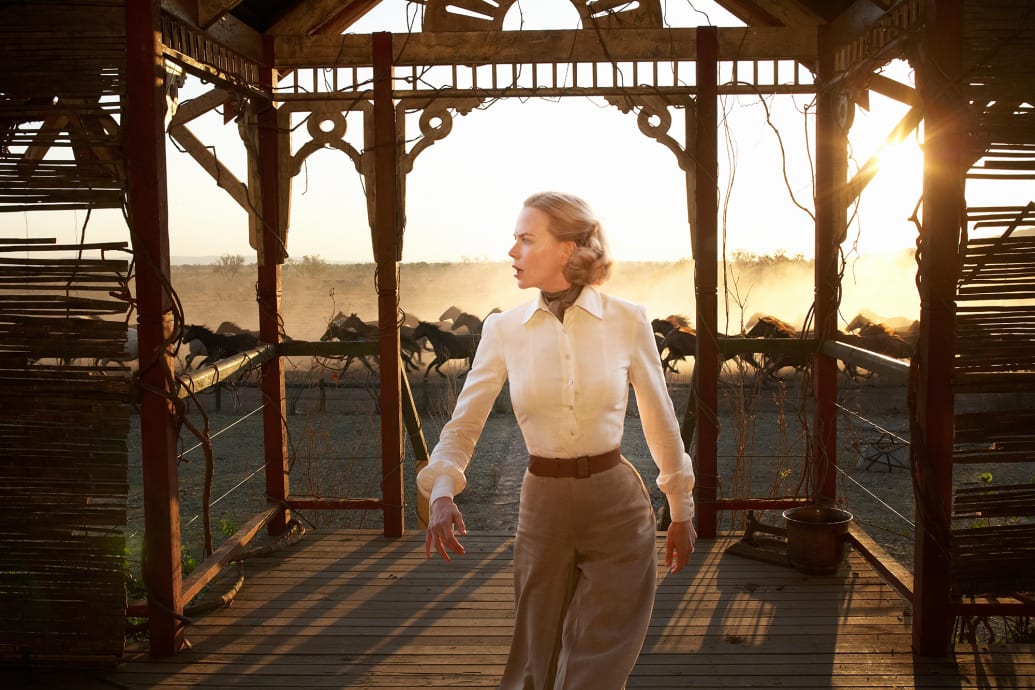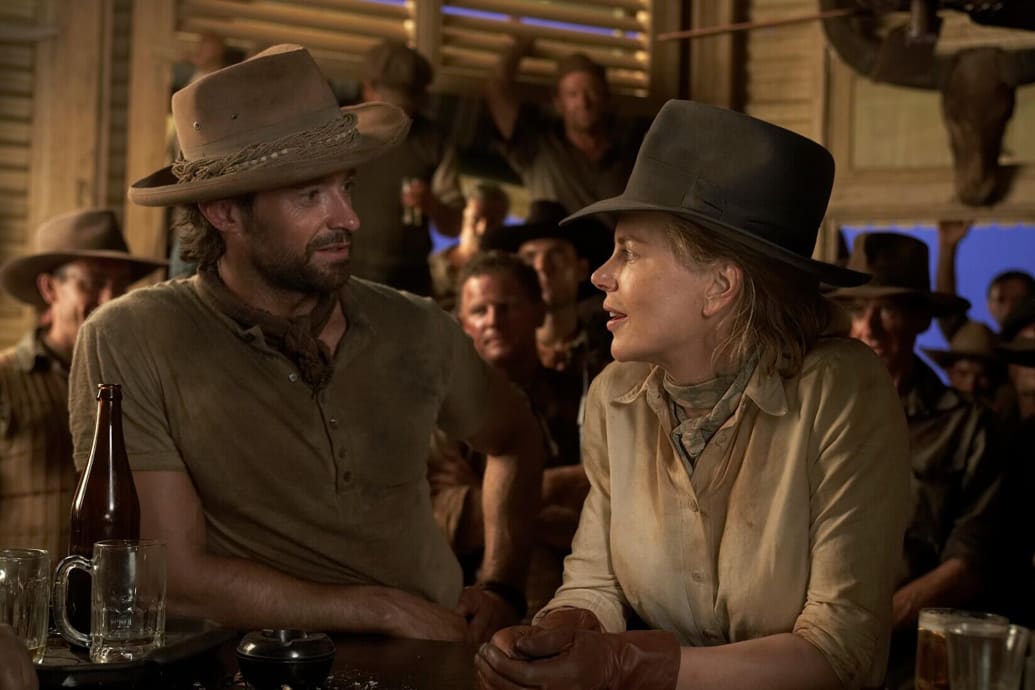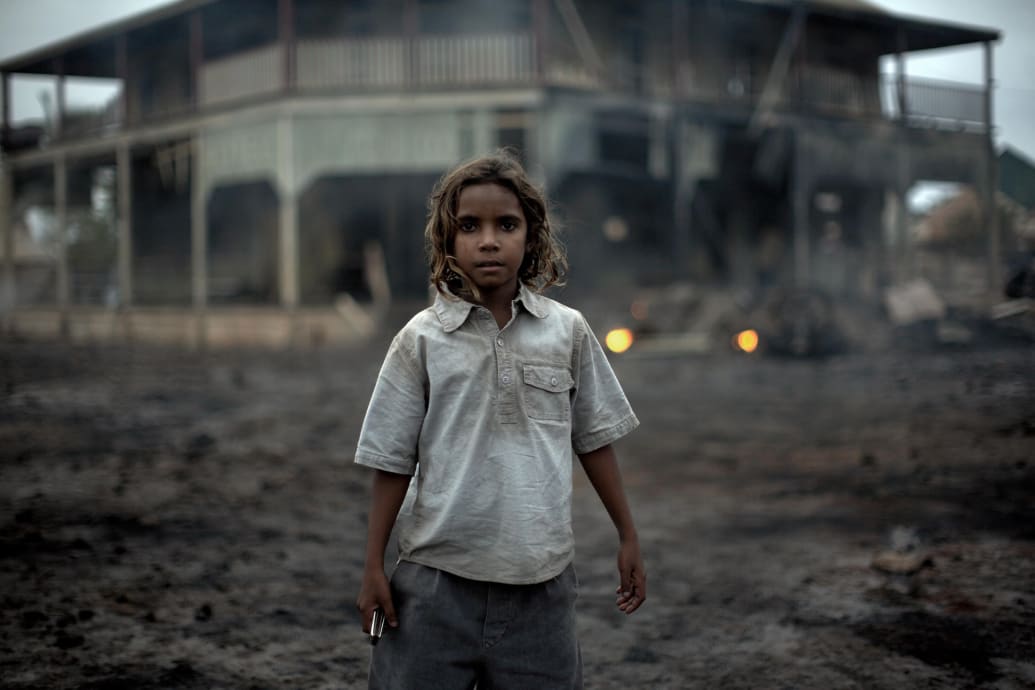“Just because it is, doesn’t mean it should be,” state both aristocrat Lady Sarah Ashley (Nicole Kidman) and cattle-herding Drover (Hugh Jackman) in Australia, thereby providing Baz Luhrmann’s 2008 romantic historical epic with its rallying cry for racial and social progress. Now, however, it also refers to the film itself, which the illustrious Moulin Rouge! and Elvis director has reimagined in grander terms as Faraway Downs, a six-part expansion that boasts approximately an hour of additional material that’s highlighted by a surprising new ending.
Premiering Nov. 26 on Hulu, it’s a revision crafted from preexisting footage and embellished with original indigenous music and animation, and it turns Luhrmann’s sweeping ode to classic Hollywood into a richer melodrama of Outback love, business rivalries, and the pain of his native country’s Stolen Generations legacy, in which mixed-race Aboriginal children were taken from their families and converted into members of white Christian society.
Though no one ever accused the 165-minute Australia of being too concise, the extended Faraway Downs (running close to 225 minutes) benefits from its more unhurried episodic pace. By taking extra time to develop its story, it places empathetic emphasis on its main characters, Lady Sarah and the Drover. They’re a from-different-worlds pair who are brought together through circumstance to save the former’s Faraway Downs estate from predatory cattle baron King Carney (Bryan Brown) and his traitorous right-hand man Fletcher (David Wenham), as well as to care for young indigenous boy Nullah (Brandon Walters), whose shaman grandfather King George (David Gulpilil) has been accused of killing Lady Sarah’s husband.
The ensuing saga is rife with stampedes, conflagrations, and twisters (oh my!), all of it underscored by references to The Wizard of Oz and energized by Luhrmann’s trademark flair. Moreover, its new conclusion lends it a bittersweetness that’s more faithfully attuned to its portrait of uneasy reconciliation and unlikely independence. Even if it doesn’t reinvent its source, Faraway Downs will no doubt be of tremendous interest to fans of the Australian auteur, as it was to us—which is why, ahead of the debut of this “film in chapters,” we spoke with Luhrmann about revisiting Australia, his attitude toward director’s cuts, and his thoughts about Sofia Coppola’s Priscilla.

Nicole Kidman as Lady Sarah Ashley.
20th Century Studios
Australia received a mixed reaction when it debuted in 2008, but none of the negative responses thought it should be longer. Why, then, add an extra hour to create Faraway Downs? Did you always view the film’s runtime as its biggest issue?
It’s like all my films, even Moulin Rouge!—there’s a line I cross where I know it’s working, but I don’t think of any of them as perfect. They tend to be like children: They grow up and they go off to school and they’re taken away from you. Certainly with Australia, it was such a difficult landing. I think what I really needed to find was, Faraway Downs is not the director’s cut of Australia. Faraway Downs has such a significant plot change in it, and I created new music with these exciting new young indigenous pop artists, and there are graphics by young indigenous graphic artists. I really looked at the underlying theme and enriched it—which is taking something like a melodrama like Gone with the Wind, flipping it upside-down, and telling it from an indigenous child’s point of view.
When I looked at the 2.5 million feet of footage that I shot—and that came about because of an accident, really—I realized that, now that we have episodic storytelling, I can lean into that. In the back of my mind, I really did shoot it as an epic, and epics are long. I just thought, one day maybe I’ll do a two-part film. But then along comes streaming, and it’s a bit like when Dickens wrote his novels—he delivered them in chapters.
It’s a chance for audiences and critics to reconsider the project.
I’ve got to be careful, because Australia had such a terrible reception in America, but Australia is still my number one biggest movie of all time in Europe. And it’s the number two biggest movie of all time in Australia. In Europe—like in Spain and France—it went for six weeks at number one. I don’t really know why, but there are people who have an incredibly visceral and emotional connection to that film. So I can’t go, oh, I did this to fix that. That’s not the road I took. It was more like I wanted to do a variation on an existing tune that I’d written if I was a composer. They are different works, but they are drawn from the same material.

Hugh Jackman and Nicole Kidman.
20th Century Studios
I assume that one of the challenges with Faraway Downs had to do with pacing. Considering that it features new sequences as well as stretches numerous pre-existing scenes, how did you reconfigure the film’s tempo?
That’s a good question. First, there’s enriching and going, alright, wouldn’t it be good if we learned how sociopathic Fletcher is when he does the deed in terms of King Carney. In Australia, you just read about it in the paper, but when you see him doing it, it’s a melodrama. The film is meant to be this old-fashioned sweeping epic with a very ugly issue at its core—and that is the issue of the Stolen Generation, when children of mixed-race were forcibly taken by the government, ripped away, and severed from their culture. That’s an ugly scar on this country’s history, and I wanted to wrap that up in a sweeping old-fashioned big romance set in the landscape.
Now having said that, there’s a big difference between enriching a sequence and stretching, for want of a better expression. We still had to keep it taut, but we were able to say, let’s learn about other things. The best example is how we reconstructed the reason that Lady Sarah stays overnight at Faraway Downs and meets the little boy. There’s a scene in which she’s going to leave, and the bad guy wants her out and she agrees. Then there’s an argument with Drover about him needing cattle and warning her that there’s a murderous warrior out there and that she’s a woman—and you can see her blanch. You see Hugh Jackman pick up on that, and he goes, oh yeah, that’s right, you’re a woman—well in that case, you should do as [Fletcher] says. And so she stays! It’s a richer telling of the stakes, which you have time for.
From a narrative standpoint, the biggest alteration is the new ending, which you obviously shot at the time of the original production. Why did you abandon it then, and why restore it now?
Let me say that the underlying theme is told from a First Nations indigenous child’s point of view, and in the beginning, it feels kind of like an old-fashioned white savior thing in which Lady Sarah is going to fix everything up. But what you learn from Drover, as he says, is that you can’t control life. You can’t control a piece of land, you can’t control a child, and you can’t control a relationship. In the end, all you’ve got is your story, so you better try to live a good one. So that was always the plan.
That makes sense.
Now, it’s a melodrama, so there’s a lot of tragic loss. And in a two-hour-and-40-minute version, tragic loss, tragic loss, tragic loss—and, by the way, we delivered Australia during the time of the economic meltdown in the States, and people were having tragic losses of their own. There was this whole debate about, well, is it just too painful, given that it all comes at you so quickly. We probably took a step aside from that resolution. But when I went back and saw the original ending, I realized that it’s important if we’re going to stick to the theme that Sarah doesn’t go on happily-ever-after. She learns that no land, no child, no person defines her, and that she has to stand strong as a woman and she is on her own. She has to face the future, and only she owns her story, so she better live a good one.
I think we were able to lean into that because it [the tragic losses] wasn’t coming at us so much; we had breathing space. From the moment I saw the footage, I knew we had to do this. Plus, there are some revelations in that final scene that are a bit of a surprise. They were even a surprise to me; I had forgotten.
Was there anything in these millions of feet of footage that you wanted to include in Faraway Downs but, for whatever reason, couldn’t? Or is this as definitive as it gets?
There are probably some things still there. Actually, I don’t think I would go back and do it. I mean, it’s possible, because it’s an experiment. I think some things you make have an epic nature. Elvis, he lived an epic life even though he only lived to 42. But Moulin Rouge! is really tight, and I don’t think it’s epic in nature; it’s just not the nature of that piece. So if someone said to me, is it possible that I’d revisit Elvis, I mean, I’ve seen a four-hour cut of Elvis, and it’s a different telling, but it’s not a different story. It’s a different way of telling that story, with different layers. With this, it’s just a pragmatic thing. I just don’t know if I could go back to Faraway Downs one more time, you know?

Brandon Walters as Nullah.
20th Century Studios
Given your willingness to recalibrate Australia into Faraway Downs, I assume you don’t feel like your theatrical cuts are sacrosanct—even if you wouldn’t necessarily revisit all of them?
No, not at all. I guess I came out of the theater and we always believed that, if you took a piece of theater, you wanted to preserve the primary material but it needs to be interpreted in different ways, at different times, in different places. Let me give you an example. When we did the theatrical version of Moulin Rouge!, I really didn’t want to direct it, so I found Alex Timbers and the writers came in and they made really strong choices that I probably wouldn’t do. It wasn’t that I would be precious; I’d be with the fans wanting to hear the new music. But you’ve got to allow, in art, things to die and new things to grow. And I don’t feel that any film I’ve made is perfect; I just know when it’s working.
You never have the same relationship to a movie that the audience has. And again, it’s a bit like children. As long as you’re not fundamentally destroying it, and if it works and it’s interpreted in a different way at a different time and at a different place, then that’s the mark of successful storytelling—that it moves through time and geography.
Although Faraway Downs is debuting on Hulu, do you still have faith in the theatrical model?
Absolutely. I’m devoted to the cinema and to the theatrical. It’s a bit like television, in that when television came along, everyone went, oh my god, the movies are dead! Well, actually, the movies just got bigger; some of the greatest movies of all time were made right after television, and were a result of television. They made movies with an attitude that we have to compel people to get out there to see the movie. It’s like the camera comes along and everyone goes, oh well, painting is over! But actually, painting just got abstract. It got interesting.
I totally believe in the theatrical experience, and I just think it’s going to get probably cooler and more interesting.
Speaking of different takes on material and subjects, what are your thoughts on Priscilla and its portrait of Elvis—which differs considerably from the one you painted in Elvis?
I haven’t seen it, number one. But Sofia is a friend of mine, and I just think that what it speaks to is that Elvis is such an important part of American culture, and of the narrative of modern America, that like any great historical figure, his life can be used as a canvas to be told in many different ways and in many different times. I’m not, in any way, going to pass judgment on Priscilla, because I haven’t seen it. But it’s just proof of the relevance of this story of this child who grows up in this black community and goes on and meets this extraordinary Svengali-like character and really changes pop cultural history. Then, in such a short time, he rises so close to the sun and gets caught in a trap that he can’t get out of and doesn’t know why. It’s operatic, that story.
I think there’ll be many Elvis retellings, from many different points of views. And that’s only a good thing.
Read More: World News | Entertainment News | Celeb News
247
